中考英语专题复习六:介词、连词考点讲解和训练
- 格式:doc
- 大小:44.50 KB
- 文档页数:6

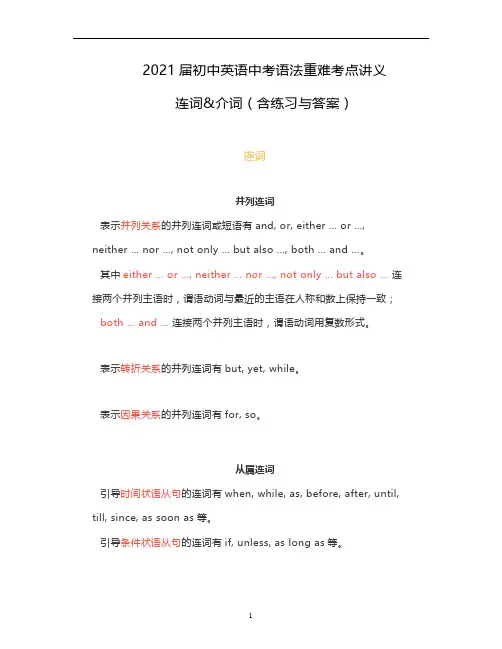
2021届初中英语中考语法重难考点讲义连词&介词(含练习与答案)连词并列连词表示并列关系的并列连词或短语有and, or, either … or …, neither … nor …, not only … but also …, both … and …。
其中either … or …, neither … nor …, not only … but also …连接两个并列主语时,谓语动词与最近的主语在人称和数上保持一致;both … and …连接两个并列主语时,谓语动词用复数形式。
表示转折关系的并列连词有but, yet, while。
表示因果关系的并列连词有for, so。
从属连词引导时间状语从句的连词有when, while, as, before, after, until, till, since, as soon as等。
引导条件状语从句的连词有if, unless, as long as等。
引导目的状语从句的连词有in order that, so that等。
so that从句中的谓语动词常含有情态动词can, could, may, might, should 等。
引导结果状语从句的连词有so that, so / such … that等。
在so / such … that结构中,so后接形容词或副词,such后接名词或名词短语。
另外,当名词前有表示数量的many, much, few或little修饰时要用so。
引导原因状语从句的连词有because, as, since等。
because的语气最强,常用来回答why引导的特殊疑问句。
引导让步状语从句的连词有although, though, even if / though, whatever, wherever, however, whoever, whenever等。
如果句中有although / though,则不能再用but。
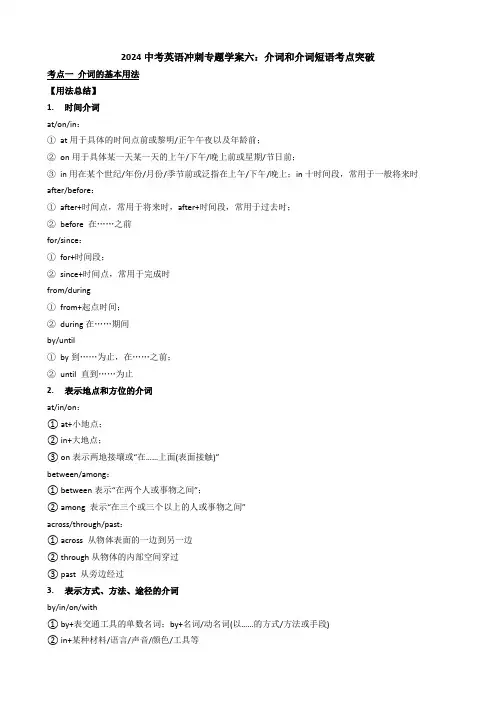
2024中考英语冲刺专题学案六:介词和介词短语考点突破考点一介词的基本用法【用法总结】1.时间介词at/on/in:①at用于具体的时间点前或黎明/正午午夜以及年龄前;②on用于具体某一天某一天的上午/下午/晚上前或星期/节日前;③in用在某个世纪/年份/月份/季节前或泛指在上午/下午/晚上;in十时间段,常用于一般将来时after/before:①after+时间点,常用于将来时,after+时间段,常用于过去时;②before 在……之前for/since:①for+时间段;②since+时间点,常用于完成时from/during①from+起点时间;②during在……期间by/until①by到……为止,在……之前;②until 直到……为止2.表示地点和方位的介词at/in/on:① at+小地点;② in+大地点;③ on表示两地接壤或“在……上面(表面接触)”between/among:① between表示“在两个人或事物之间”;② among 表示“在三个或三个以上的人或事物之间”across/through/past:① across 从物体表面的一边到另一边② through从物体的内部空间穿过③ past 从旁边经过3.表示方式、方法、途径的介词by/in/on/with① by+表交通工具的单数名词;by+名词/动名词(以……的方式/方法或手段)② in+某种材料/语言/声音/颜色/工具等③on表示用网络、、收音机、电视等④with表示“用,以,借助于”,其后常接具体的工具考点二其他常考介词的用法【用法总结】except 不包括后面提到的人或事物besides 包括后面提到的人或事物for 为了;给;由于;前往with 和……一起;有;伴随;带有……心情/态度as作为;以考点三含有介词的短语【用法总结】at 短语:at first 首先;at last 最后;at least至少;at the age of在……岁时by 短语:by hand手工;by the way 顺便问一下;by the end of到……为止;by turns 轮流in 短语:in fact 事实上;in the end 最后;in order to为了;in a hurry 匆忙on 短语:on business 出差;on duty 值日;on foot 步行其他短语:as a result 结果;as for 至于;as usual和往常一样;for example例如【考点跟踪练习】I.用适当的介词填空。
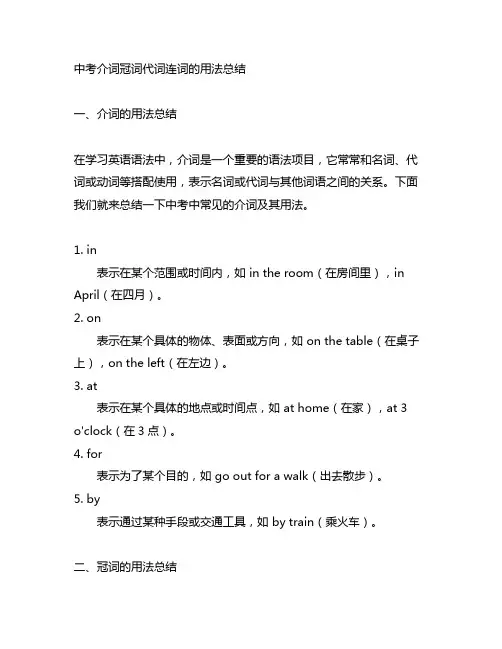
中考介词冠词代词连词的用法总结一、介词的用法总结在学习英语语法中,介词是一个重要的语法项目,它常常和名词、代词或动词等搭配使用,表示名词或代词与其他词语之间的关系。
下面我们就来总结一下中考中常见的介词及其用法。
1. in表示在某个范围或时间内,如 in the room(在房间里),in April(在四月)。
2. on表示在某个具体的物体、表面或方向,如 on the table(在桌子上),on the left(在左边)。
3. at表示在某个具体的地点或时间点,如 at home(在家),at 3 o'clock(在3点)。
4. for表示为了某个目的,如 go out for a walk(出去散步)。
5. by表示通过某种手段或交通工具,如 by train(乘火车)。
二、冠词的用法总结冠词是英语中一个比较难点的语法项目,分为定冠词“the”和不定冠词“a/an”。
下面我们来总结一下中考中常见的冠词用法。
1. 定冠词“the”表示特指,如 the sun(太阳)。
2. 不定冠词“a/an”表示泛指,如 a book(一本书)。
三、代词的用法总结代词是用来代替名词的词语,它能够减少重复,使语言更加简洁。
在中考中,代词也是一个重要的语法项目。
下面我们来总结一下中考中常见的代词及其用法。
1. 人称代词主格:I(我)、you(你)、he(他)、she(她)、it(它)、we(我们)、you(你们)、they(他们)。
宾格:me(我)、you(你)、him(他)、her(她)、it (它)、us(我们)、you(你们)、them(他们)。
形容词性:my/mine(我的)、your/yours(你的)、his(他的)、her/hers(她的)、its(它的)、our/ours(我们的)、your/yours(你们的)、their/theirs(他们的)。
2. 物主代词指代名词所有物,如 mine(我的)、yours(你的)、his(他的)、hers(她的)、its(它的)、ours(我们的)、yours(你们的)、theirs(他们的)。
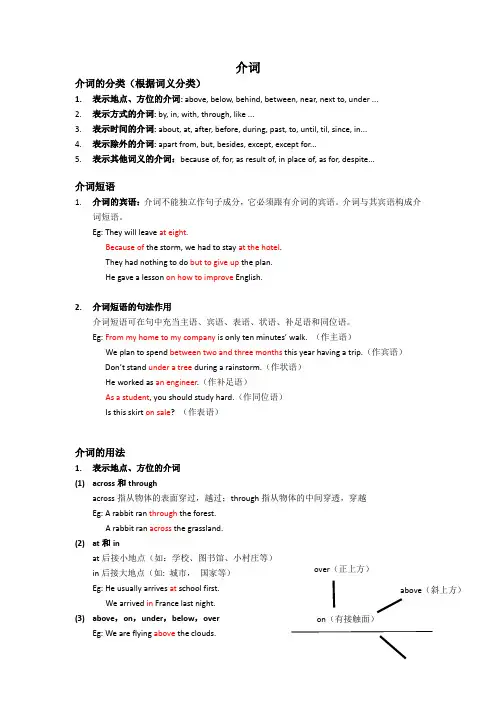
介词介词的分类(根据词义分类)1.表示地点、方位的介词: above, below, behind, between, near, next to, under ...2.表示方式的介词: by, in, with, through, like ...3.表示时间的介词: about, at, after, before, during, past, to, until, til, since, in...4.表示除外的介词: apart from, but, besides, except, except for...5.表示其他词义的介词:because of, for, as result of, in place of, as for, despite...介词短语1.介词的宾语:介词不能独立作句子成分,它必须跟有介词的宾语。
介词与其宾语构成介词短语。
Eg: They will leave at eight.Because of the storm, we had to stay at the hotel.They had nothing to do but to give up the plan.He gave a lesson on how to improve English.2.介词短语的句法作用介词短语可在句中充当主语、宾语、表语、状语、补足语和同位语。
Eg: From my home to my company is only ten minutes’ walk. (作主语)We plan to spend between two and three months this year having a trip.(作宾语)Don’t stand under a tree during a rainstorm.(作状语)He worked as an engineer.(作补足语)As a student, you should study hard.(作同位语)Is this skirt on sale? (作表语)介词的用法1.表示地点、方位的介词(1)across和throughacross指从物体的表面穿过,越过;through指从物体的中间穿透,穿越Eg: A rabbit ran through the forest.A rabbit ran across the grassland.(2)at和inat后接小地点(如:学校、图书馆、小村庄等)in后接大地点(如: 城市,国家等)Eg: He usually arrives at school first.We arrived in France last night.(3)above,on,under,below,overEg: We are flying above the clouds.on(有接触面)over(正上方)There is an eraser on the desk.A cat is under the bed.The sun sank below the horizon.There is a bridge over the river.(4) between 和amongbetween 指两者之间,among 指三者或三者以上之中。
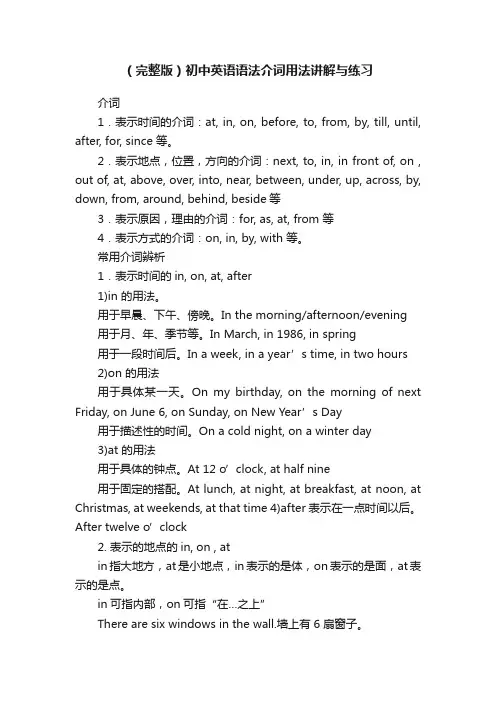
(完整版)初中英语语法介词用法讲解与练习介词1.表示时间的介词:at, in, on, before, to, from, by, till, until, after, for, since 等。
2.表示地点,位置,方向的介词:next, to, in, in front of, on , out of, at, above, over, into, near, between, under, up, across, by, down, from, around, behind, beside等3.表示原因,理由的介词:for, as, at, from 等4.表示方式的介词:on, in, by, with 等。
常用介词辨析1.表示时间的in, on, at, after1)in 的用法。
用于早晨、下午、傍晚。
In the morning/afternoon/evening用于月、年、季节等。
In March, in 1986, in spring用于一段时间后。
In a week, in a year’s time, in two hours2)on 的用法用于具体某一天。
On my birthday, on the morning of next Friday, on June 6, on Sunday, on New Year’s Day用于描述性的时间。
On a cold night, on a winter day3)at 的用法用于具体的钟点。
At 12 o’clock, at half nine用于固定的搭配。
At lunch, at night, at breakfast, at noon, at Christmas, at weekends, at that time 4)after 表示在一点时间以后。
After twelve o’clock2. 表示的地点的in, on , atin指大地方,at是小地点,in表示的是体,on表示的是面,at表示的是点。
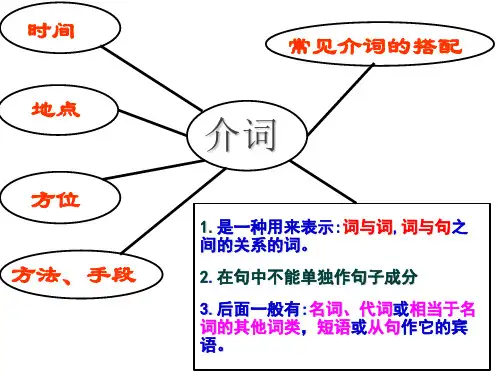
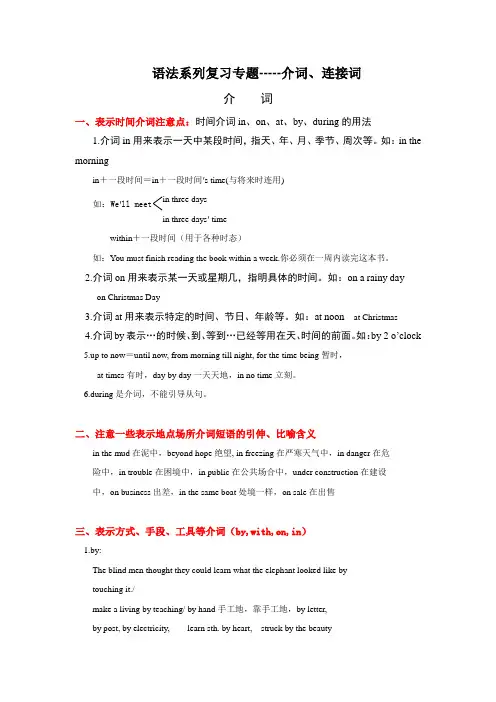
语法系列复习专题-----介词、连接词介词一、表示时间介词注意点:时间介词in、on、at、by、during的用法1.介词in用来表示一天中某段时间,指天、年、月、季节、周次等。
如:in the morningin+一段时间=in+一段时间's time(与将来时连用)如:We'll meetin three days' timewithin+一段时间(用于各种时态)如:You must finish reading the book within a week.你必须在一周内读完这本书。
2.介词on用来表示某一天或星期几,指明具体的时间。
如:on a rainy dayon Christmas Day3.介词at用来表示特定的时间、节日、年龄等。
如:at noon at Christmas4.介词by表示…的时候、到、等到…已经等用在天、时间的前面。
如:by 2 o’clock5.up to now=until now, from morning till night, for the time being暂时,at times有时,day by day一天天地,in no time立刻。
6.during是介词,不能引导从句。
二、注意一些表示地点场所介词短语的引伸、比喻含义in the mud在泥中,beyond hope绝望, in freezing在严寒天气中,in danger在危险中,in trouble在困境中,in public在公共场合中,under construction在建设中,on business出差,in the same boat处境一样,on sale在出售三、表示方式、手段、工具等介词(by,with,on,in)1.by:The blind men thought they could learn what the elephant looked like bytouching it./make a living by teaching/ by hand手工地,靠手工地,by letter,by post, by electricity, learn sth. by heart, struck by the beauty因美丽而着迷by means of用…手段,方式;by way of经由,取道于…learn English by/ over/ through/ on the radioHe was paid by the hour/ the day/ month/…他按时/日/月/…被付给工钱。
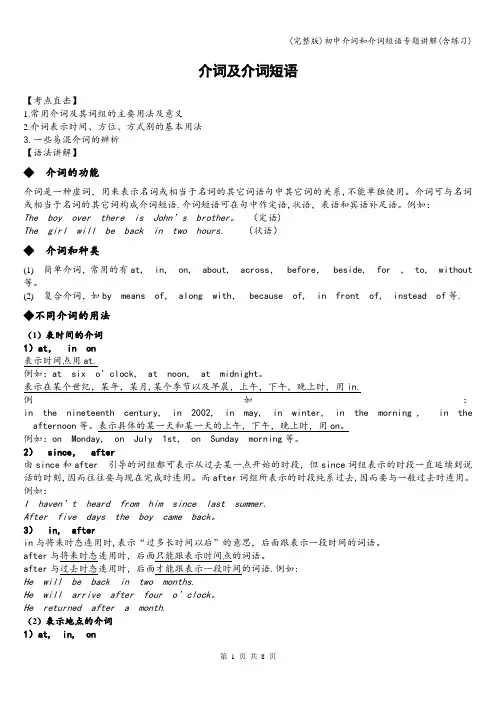
介词及介词短语【考点直击】1.常用介词及其词组的主要用法及意义2.介词表示时间、方位、方式别的基本用法3.一些易混介词的辨析【语法讲解】◆介词的功能介词是一种虚词,用来表示名词或相当于名词的其它词语句中其它词的关系,不能单独使用。
介词可与名词或相当于名词的其它词构成介词短语.介词短语可在句中作定语,状语,表语和宾语补足语。
例如:The boy over there is John’s brother。
(定语)The girl will be back in two hours. (状语)◆介词和种类(1)简单介词,常用的有at, in, on, about, across,before,beside, for , to, without 等。
(2)复合介词,如by means of, along with,because of, in front of, instead of等.◆不同介词的用法(1)表时间的介词1)at,in on表示时间点用at.例如:at six o’clock, at noon, at midnight。
表示在某个世纪,某年,某月,某个季节以及早晨,上午,下午,晚上时,用in.例如:in the nineteenth century, in 2002, in may, in winter, in the morning,in the afternoon等。
表示具体的某一天和某一天的上午,下午,晚上时,用on。
例如:on Monday, on July 1st, on Sunday morning等。
2)since,after由since和after 引导的词组都可表示从过去某一点开始的时段,但since词组表示的时段一直延续到说话的时刻,因而往往要与现在完成时连用。
而after词组所表示的时段纯系过去,因而要与一般过去时连用。
例如:I haven’t heard from him since last summer.After five days the boy came back。
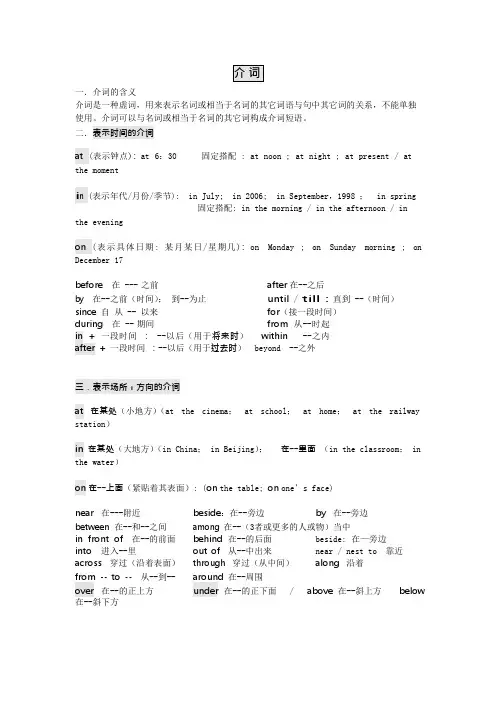
一.介词的含义介词是一种虚词,用来表示名词或相当于名词的其它词语与句中其它词的关系,不能单独使用。
介词可以与名词或相当于名词的其它词构成介词短语。
二.表示时间的介词at (表示钟点): at 6:30 固定搭配 : at noon ; at night ; at present / at the momenti n(表示年代/月份/季节): in July; in 2006; in September,1998 ;in spring固定搭配: in the morning / in the afternoon / inthe eveningon (表示具体日期: 某月某日/星期几): on Monday ;on Sunday morning ;on December 17before 在 --- 之前after 在--之后by在--之前(时间);到--为止until/ till:直到 --(时间)since 自从 -- 以来for(接一段时间)during 在 -- 期间from 从--时起in + 一段时间:--以后(用于将来时)within --之内after + 一段时间:--以后(用于过去时)beyond --之外三.表示场所,方向的介词at在某处(小地方)(at the cinema; at school; at home; at the railway station)in在某处(大地方)(in China; in Beijing);在--里面(in the classroom; in the water)on 在--上面(紧贴着其表面): (on the table; on one’s face)near 在---附近beside:在--旁边by 在--旁边between 在--和--之间among 在--(3者或更多的人或物)当中in front of 在--的前面behind 在--的后面beside: 在—旁边into 进入--里out of 从--中出来near / nest to 靠近across 穿过(沿着表面)through 穿过(从中间)along 沿着from -- to -- 从--到-- around 在--周围over 在--的正上方under 在--的正下面/ above 在--斜上方below 在--斜下方四.其他介词in用(某种语言),穿着(某种颜色的衣服)about 大约;关于from 来自---as像--(接句子);正如--; like 像--(接单词)with 和--起;用-- without 没有--by通过(某种方式或手段);乘坐by bus(train /plane /ship /bike)on foot五.重要介词辨析(1)on, over 与aboveOn 在……上面与物体表面有接触面Over 在……上方垂直正上方,表示“跨越,覆盖”Above 在……上方“在……(偏)上方”,表示两者不接触例如:There is a bag on the desk.The lamp is over the table.The heaven is above us.(苍天在上。

第06讲介词目录01 考情透视.目标导航 (2)02 知识导图.思维引航 (3)03 考点突破.考法探究 (4)【基础详单】知识点1 介词概述、命题及解题方向 (4)知识点2 介词的句法功能 (4)考点一介词的基本用法知识点1 介词形式的分类 (5)知识点2 常用介词辨析 (6)知识点3 重难易错常考其它介词 (10)考点二介词和其它词类的搭配知识点1 介词和名词的搭配 (12)知识点2 介词和形容词的搭配 (14)知识点3 介词和其它词类的搭配 (15)04真题练习·命题洞现1.真题实战 (16)2.命题演练·······························································································································【基础详单】知识点1 介词概述介词是一种虚词。
中考英语专题复习六:介词、连词考点讲解和训练 【考点直击】 1. 常用介词及其词组的主要用法和意义; 2. 常用动词、形容词与介词、副词的固定搭配及其意义。 3. 并列连词and, but, or, so等的主要用法; 4. 常用的从属连词的基本用法
【名师点睛】 1. 介词的功能 介词是一种虚词,用来表示名词或相当于名词的其它词语句中其它词的关系,不能单独使用。介词可与名词或相当于名词的其它词构成介词短语。介词短语可在句中作定语,状语,表语和宾语补足语。例如: The boy over there is John’s brother. (定语) The girl will be back in two hours. (状语) Our English teacher is from Australia. (表语) Help yourself to some fish. (宾语补足语) 2. 常用介词的用法辨析 (1)表时间的介词 1)at, in on 表示时间点用at。例如:at six o’clock, at noon, at midnight。表示在某个世纪,某年,某月,某个季节以及早晨,上午,下午,晚上时,用in。例如:in the ninettenth century, in 2002, in may, in winter, in the morning, in the afternoon等。表示具体的某一天和某一天的上午,下午,晚上时,用on。例如:on Monday, on July 1st, on Sunday morning等。 2) since, after 由since和after 引导的词组都可表示从过去某一点开始的时段,但since词组表示的时段一直延续到说话的时刻,因而往往要与现在完成时连用。而after词组所表示的时段纯系过去,因而要与一般过去时连用。例如: I haven’t heard from him since last summer. After five days the boy came back. 3) in, after in与将来时态连用时,表示“过多长时间以后”的意思,后面跟表示一段时间的词语。After与将来时态连用时,后面只能跟表示时间点的词语。After与过去时态连用时,后面才能跟表示一段时间的词语。例如: He will be back in two months. He will arrive after four o’clock. He returned after a month. (2)表示地点的介词 1)at, in, on at一般指小地方;in一般指大地方或某个范围之内;on往往表示“在某个物体的表面”。例如: He arrived in Shanghai yesterday. They arrived at a small village before dark. There is a big hole in the wall. The teacher put up a picture on the wall. 2) over, above, on over, on和above都可表示“在……上面”,但具体含义不同。Over表示位置高于某物,在某物的正上方,其反义词是under。 above也表示位置高于某物,但不一定在正上方,其反义词是below。On指两个物体表面接触,一个在另一的上面。例如: There is a bridge over the river. We flew above the clouds. They put some flowers on the teacher’s desk. 3) across, through across和through均可表示“从这一边到另一边”,但用法不同。Across的含义与on有关,表示动作在某一物体的表面进行。Throgh的含义与in有关,表示动作是在三维空间进行。例如: The dog ran across the grass. The boy swam across the river. They walked through the forest. I pushed through the crowds. 4) in front of, in the front of in front of 表示“在某人或某物的前面”,在某个范围以外;in the front of 表示“在……的前部”,在某个范围以内。例如: There are some tall trees in front of the building. The teacher is sitting in the front of the classroom. 3. 介词的固定搭配 介词往往同其他词类形成了固定搭配关系。记住这种固定搭配关系,才能正确使用介词。 (1)介词与动词的搭配 listen to , laugh at, get to, look for wait for, hear from, turn on, turn off, worry about, think of, look after, spend…on…, 等。 (2)介词与名词的搭配 on time, in time, by bus, on foot, with pleasure, on one’s way to, in trouble, at breakfast, at the end of, in the end等。 (3)介词与形容词的搭配 be late for, be afraid of, be good at, be interested in, be angry with, be full of, be sorry for等。 4. 连词的功能 用来连接词,短语,从句或句子的词叫连词。连词是一种虚词,在句中不能单独使用。连词可分为两类:并列连词和从属连词。 5. 并列连词 并列连词用来连接具有并列关系的词,短语或句子。常见的并列连词有: (1)表并列关系的and, both…and, not only…but also, neither…nor等。 (2)表选择关系的or, either…or等。 (3)表转折关系的but, while等。 (4)表因果关系的for, so等。 6. 从属连词 从属连词用来引导从句。常见的从属连词有: (1)引导时间状语从句的after, before, when, while, as, until, till, since, as soon as等。(2)引导条件状语从句的if, unless等。 (3)引导原因状语从句的because, as, since等。 (4)引导目的状语从句的so that, in order that等。 (5)引导让步状语从句的though, although, even if等。 (6)引导结果状语从句的so that, so…that, such…that等。 (7)引导比较状语从句的than, as…as等。 (8)引导名词从句的that, if , whether等。 7. 常用连词的用法辨析 (1) while, when, as 这三个连词都可引导时间状语从句,但用法有所不同。 1) 当某事正在进行的时候,又发生了另一件事。While, when, as 都可用来引导表示“背景”的时间状语从句。例如: As/When/While I was walking down the street I noticed a police car. 2) 当两个长动作同时进行的时候,最常用的是while。例如: While mother was cooking lunch, I was doing my homework. 3) 当两个动作都表示发展变化的情况时,最常用的是as。例如: As children get older, they become more and more interested in things around them. 4) 当两个短动作同时发生时,或表示“一边…一边…”时,最常用as。例如: Just as he caught the fly, he gave a loud cry. She looked behind from time to time as she went 5) 当从句的动作先于主句的动作时,通常用when。例如: When he finished his work, he took a short rest. 6) 当从句是瞬间动作,主句是延续性动作时,通常用when。例如: When John arrived I was cooking lunch. (2)as, because, since , for 这四个词都可表原因,但用法有区别。 1) 如果原因构成句子的最主要部分,一般用because。因此,because引导的从句往往放在句末。例如: I stayed at home because it rained. ---Why aren’t you going? ---Because I don’t want to. 2) 如果原因已被人们所知,或不如句子的其它部分重要,就用as或since。Since比as稍微正式一点。As和since 引导的从句一般放在句子的开头。例如: As he wasn’t ready, we left without him. Since I have no money, I can’t buy any food. 3) for用来补充说明一种理由,因此,for引导的从句几乎可以放在括号里。For引导的句子不放在句子的开头。例如: I decided to stop and have lunch----for I was feeling quite hungry. (3)if, whether if和whether都可作“是否”讲,在引导宾与从句是一般可互换。例如: I wonder whether (if) you still study in that school. I don’t know whether (if) he likes that film. 在下列情况下,只能用whether,不能用if: 1) 引导主语从句时。例如: Whether he will come to the party is unknown. 2) 引导表语从句时。例如: The question is whether I can pass the exam. 3) 在不定式前。例如: I haven’t made up my mind whether to go there or not. (4)so…that, such...that 1) so…that中的so是个副词,其后只能跟形容词或副词,而such...that中的such是个形容词,后接名词或名词短语。例如: I’m so tired that I can’t walk any farther. It was such a warm day that he went swimming. 2) 如果在名词之前有many, much, little, few时,用so,不用such。例如: He has so little education that he is unable to get a job. I have had so many falls that I am black and blue all over. (5)either…or…, neither…nor, not only…but also… 这三个连词词组都可连接两个并列成分。当它们连接两个并列主语时, 谓语动词要随相邻的主语变化。例如: Either you or he is wrong. Neither he nor his children like fish. Not only the teacher but also the students want to buy the book. (6)although, but 这两个连词不能用在同一个句子中。例如:我们不能说“Although he is over sixty, but he works as hard as others.”这个句子应改为:Although he is over sixty, he